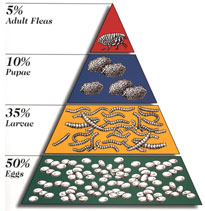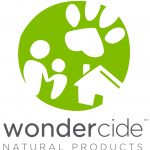Yes, There are Sane Alternatives to Poisons
There is probably no area in a pet’s life that takes so much attention to detail as flea control. To do this well makes life with animals easy and fun, yet to do it wrong or incompletely can make your pet sick and make your life together miserable. Tick control has long been a challenge to do non-toxically, but I have some answers. Put non-toxic flea and tick control to work for your animals today. I’ll show you how.
Breaking the Pest Population Down
Let’s first consider the flea’s life cycle a bit. If you picture a pyramid of fleas as representation of the relative numbers of the various life stages that exist at any given moment, the bothersome adult fleas that bite and cause problems would be only the very top, about 5% of the total. The broad base of the pyramid is the vast number of eggs, 50% of the total population. These are laid both on and off the host animal, and are awaiting proper conditions to hatch and begin a new generation. The next major population segment is the larvae (35% of the total), which emerge from the eggs and feed on debris and organic matter in carpets, soil, or in cracks and baseboards. Then, above these, a relatively small segment of the total (10%), are the pupae, suspended in a cocoon that seems impervious to all control efforts, natural or otherwise.
BOTTOM LINE: HIT THE BASE — EGGS AND LARVAE!
So, from a purely statistical point of view, the efforts to control this pest that are directed at the eggs and larvae will yield the best results, and prevent future generations from being born. Unfortunately, most of the flea control products are directed at the adults, and most of these are toxic chemicals that are poisonous to the pet and its person.
DON’T MAKE THINGS WORSE
The end result of bombs, sprays, dips, “spot-ons,” and the like, is resistant fleas and sick people and pets. Why? It’s the same story that happens with any antibiotic, pesticide, or herbicide: a certain percentage of every population is resistant to any given chemical. New chemicals are sought that are increasingly less safe to the humans and animals they contact, and resistance develops at each new turn. In case you’ve had only good experiences putting these topical pesticides on your animal, your neighbors have not, and the EPA is investigating (you can check that out on your own). The majority of the incidents reported to EPA are related to flea and tick treatments with EPA-registered spot-on products.
The good news is that there are effective, safe, non-toxic ways to address the flea population where it counts and not make everyone sick in doing so. There are two main areas to address the major segments of the flea population: the eggs and larvae (remember, they’re 85% of the population).
OUTDOORS
If your animals spend a fair amount of time in a grassy yard, there is a biological control that can be used to prey on the flea larvae in the soil. NEMATODES, a tiny worm, is applied via lawn sprayer, and, within 24 hours, brings about a 90% decrease in the number of flea larvae. Nematodes have no bad effect on anything but the pest, and they have the side benefit of helping in the garden against cutworms and grubs. Pretty cool! Reintroduce periodically, because they eat all the prey species and die off for lack of food.
INDOORS
You can do a very inexpensive treatment that gets to the larvae quite effectively without much risk of resistance developing and without significant toxicity to people or pets.
CARPET: There are a lot of boric acid products on the market that are marketed as flea controllers or carpet deodorizers. They work by putting a powder in the carpet that remains there even after vacuuming (because of the fine particle size). Flea larvae are killed by contacting the borate power, yet the animals in the house are safe. Try FLEAGO Natural Flea Control or good ‘OLE 20 MULE TEAM Borax. Shake the powder on the carpet until it turns lightly white, brush it in with a broom, and then vacuum the carpet. Most applications are good for a year. If you shampoo your carpet, you’ll of course have to repeat the application.
BARE FLOORS: There is a very safe chemical called NYLAR, which is a flea growth regulator. This is sprayed on floors, kennels, bedding, and any furniture that is commonly used as a resting place for the pet. Its action is to prevent eggs from hatching and larvae from molting to adults by mimicking a juvenile hormone in the insect, and keeps the young from ever becoming adults. Once-a-year application should be sufficient in most cases. It is difficult to find this chemical alone. It is often combined with adulticides (aka, poisons). So it becomes imperative for you to be a label detective.
THINK HIDEOUTS! The key indoors is thinking of all the places where your pet rests because these are all places where flea eggs roll off and try to get a new generation started. If the sofa is a dog bed, the cushions need to be pulled and the crack between back and seat treated with borates or Nylar. If your cat climbs into bed with you, normal washing of bedding in hot water and drying in the dryer is sufficient to prevent this area from becoming a breeding ground. If you’re still seeing fleas after applying these non-toxic flea control methods, think again of ALL the places your pet rests. Are they treated in ways that prevent fleas from growing to the next generation?
THE FLEA-RIDDEN OR FLEA-PRONE ANIMAL
For those adult fleas bothering your pet, seriously think about boosting the immune system, and a good FLEA COMB is your best tool while you wait for the immune system and your chosen control to begin to work. Adult fleas may live many weeks, and you may get some new ones born on occasion from the pupae that are awaiting proper conditions to hatch, so there needs to be some attention paid here, as well as a certain amount of patience. Typically, this safer approach takes about a month to show a noticeable decrease in the flea population. Use the flea comb on a daily basis, and as you catch fleas, dunk the comb into a glass of soapy water to drown them.
Did you know that a bath with anything that makes lather will drown fleas? It’s true! Just leave the lather on for 3-5 minutes, and no toxic chemicals need be used. Now, I don’t recommend bathing as a means of flea control routinely, as bathing dries out the skin. And it certainly won’t control fleas alone. But, if you’re in a tight spot and the fleas have exploded, it can be a quick solution to get you some sanity. And if you add a dropper or two of essential oils (lavender, citronella, pennyroyal, eucalyptus, etc.) to the bath, you’ll have a pretty good repellent to discourage the next wave from jumping on your pal.
NOTE: this is really not a cat recommendation, as cats can be quite sensitive to essential oils and get sick from them. Best to stick to the dogs for this one, or at least be very careful with the dose in cats.
There have been very few choices I’d trust in pest control, but I’ve come upon one that gets the job done for both premises pest control and on-the-animal prevention: natural cedar oil products from WONDERCIDE. Cedar oil works well on both fleas and ticks (and yes, bedbugs) by interrupting their pheromones, which is the way they communicate and find their prey and their mates. The topical product, PETS & HOME (available through Idyllic Paws), kills fleas and ticks on your dog, cat, and in the home and acts as a repellant when used before going into areas that may be infested with either. The company says this is safe for cats, but I’m conservative here. Cats are just more sensitive to volatile compounds in general, and that includes essential oils. So for cats, I’d start with a small area of the body, mist on some PETS & HOME spray, and watch for any signs of discomfort or vomiting. If all is well in 12 hours, carry on with the rest of the body. If you see a reaction, wash your cat well to remove the cedar oil.
Wondercide also makes a product for outdoor control called Yard & Garden. that kills and repels fleas, ticks & 100s of other pests, while being safe for beneficial insects.
HERBAL POWDER
There are, I believe, a few commercial herbal powders that work quite well to repel pests, but I have never tried them. I prefer to make my own and here is how you can do that too: Make your own All-Natural Flea & Tick Powder
WHAT ABOUT GARLIC AND YEAST?
Sure, it can help to feed garlic and nutritional yeast to dogs and cats. This gives them some extra B vitamins and makes them not so tasty to fleas. The only caution is that you not depend on this as your sole means of controlling fleas. For cats, a teaspoonful of yeast flakes and a small clove of garlic daily should be adequate. For big breeds of dogs, up to 1/4 cup of yeast and a few big cloves is a decent dose, and for those in between, adjust according to body weight. And a caution: garlic in high doses, like onions, causes anemia in pets. Err on the side of caution, always, and keep the doses low, knowing the goal is in treating the environment, not the pet.
WHAT DO YOU THINK ABOUT THE “FLEA & TICK PILL” ?
I do NOT like it. Mainly because I see us already subjecting our animals to a stew of chemicals that they are not genetically equipped to deal with. Evolution has not equipped them (or us) to detoxify and live compatibly with these foreign compounds — they are too new to the scene. While the company claims safety, the testing data is relatively short term (6-8 months at the longest), and once it’s out on the market, there is no incentive to follow that product long term to see if there is any greater incidence of cancer, allergies, autoimmune disorders, etc. in those animals taking the pill.
Also, any chemical that works by polluting the blood of the animal as a way to get to the flea and tick leaves me a bit cold. Think about it in human terms. Say a big petrochemical/pharmaceutical firm came out with a monthly mosquito control pill for you to take. The instructions are to take it with food, and the mosquitoes must bite you to get a drink of the chemical; then their eggs would fail to hold together and slowly there would be fewer mosquitoes. Would you take it??
HOW ABOUT THE TOPICAL TUBES?
Man, what a convenience! Just don’t get it on YOUR skin. Wait. What? Read that label again, will you? It says it’s OK to put on Spot and Fluffy’s skin, but not OK to get it on MINE. Hmmm, and I shouldn’t eat, drink, smoke, or scratch myself while applying this? This doesn’t sound safe now, does it?
THE BOTTOM LINE
Finally, fleas and ticks, like any parasite, are more attracted to the weak animals. You’ll see this clearly in multi-animal households. “Old Bowzer really gets the most fleas. Always has.” So, it pays big dividends to have your animal as healthy as possible, not only for fleas, but for heartworm prevention, disease resistance, stamina, and long life. That’s really the goal for all problems.


Recent Comments